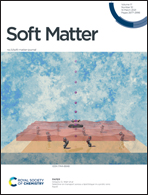Needle insertion-induced quasiperiodic cone cracks in hydrogel†
Abstract
Needle insertion, a standard process for various minimally invasive surgeries, results in tissue damage which sometimes leads to catastrophic outcomes. Opaqueness and inhomogeneity of the tissues make it difficult to observe the underlying damage mechanisms. In this paper, we use transparent and homogeneous polyacrylamide hydrogel as a tissue mimic to investigate the damages caused during needle insertion. The insertion force shows multiple events, characterised by a gradual increase in the force followed by a sharp fall. Synchronised recording of the needle displacement into the gel shows that each event corresponds to propagation of stable cone crack. Though sporadic uncontrolled cracking has been discussed earlier, this is the first report of nearly periodic, stable and well-controlled 3-D cone cracks inside the hydrogel during deep penetration. We show that the stress field around the needle tip is responsible for the symmetry and periodicity of the cone cracks. These results provide a better understanding of the fracture processes in soft and brittle materials and open a promising perspective in needle designs and the control of tissue damages during surgical operations.



 Please wait while we load your content...
Please wait while we load your content...